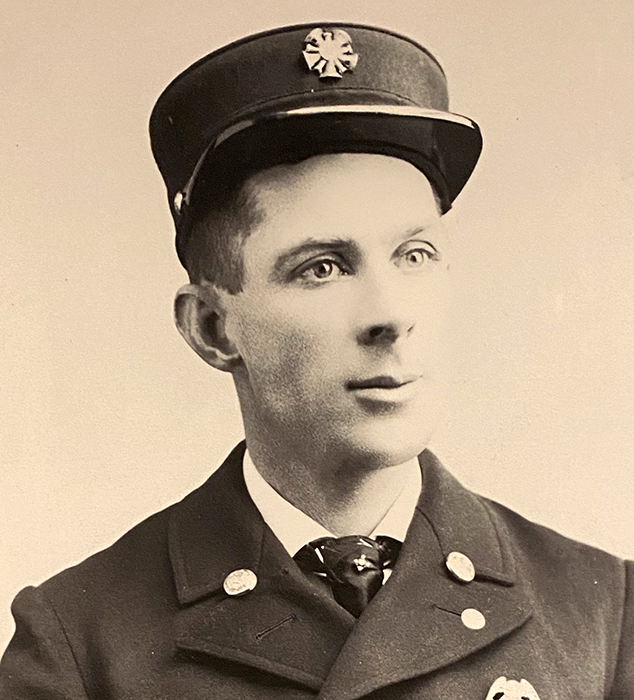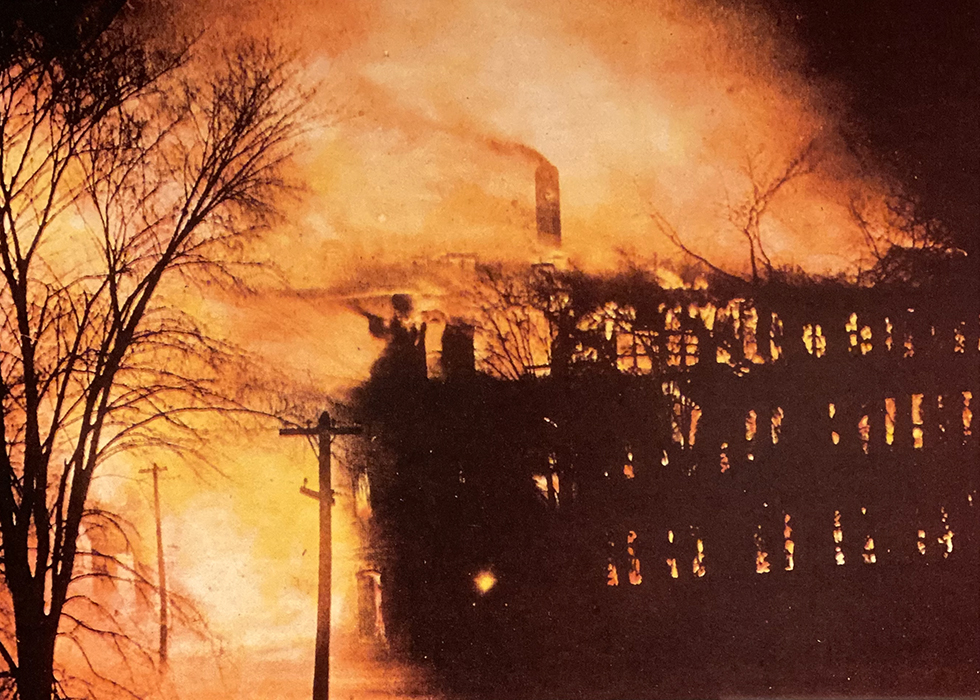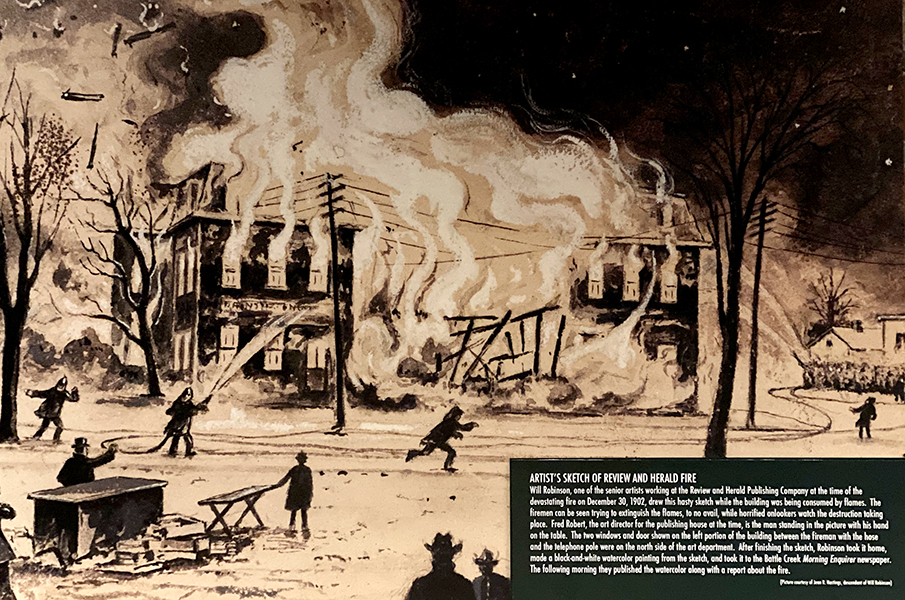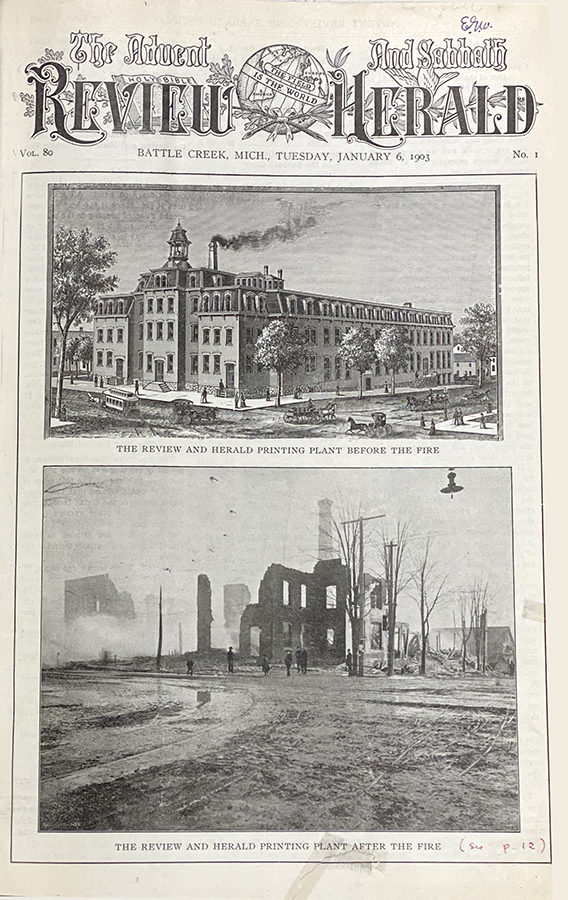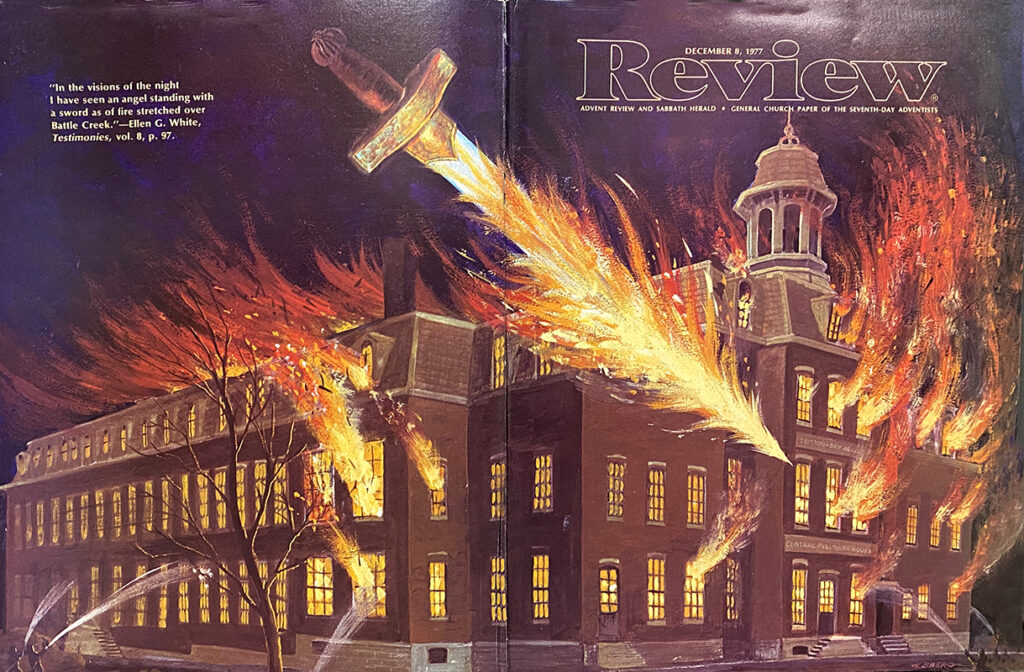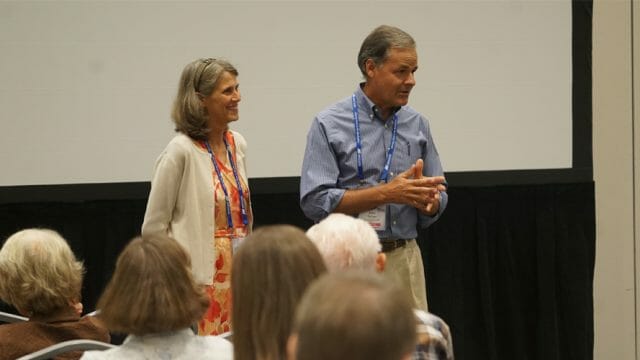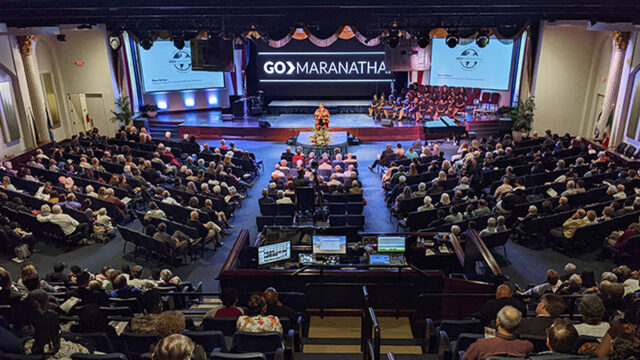From private letters and other sources the author reconstructs the story of the Review and Herald fire and the subsequent move of the publishing house to Washington, D.C.

On December 30, 1902, the Review and Herald Publishing House burned to the ground. This was the second major fire for an Adventist institution in Battle Creek, Michigan—the first being the Battle Creek Sanitarium on February 18, 1902. Below is a fairly lengthy account of the Review fire by Arthur L. White that appeared in the December 8, 1977, Adventist Review. White was the grandson of James and Ellen White. At the time of publication, Arthur White was serving as the secretary of the Ellen G. White Estate. He passed away in 1991.—Editors.
Tuesday evening, December 30, 1902, began quietly and peacefully in Battle Creek. Though it was winter, no snow was on the ground. Most of the 300 employees (see Supplement to Review and Herald, April 28, 1903) of the Review and Herald publishing house had left their machines and editorial offices for the day. A few workers had come in for the night shift. A. G. Daniells, 44, the newly elected leader of the General Conference, was still in his office on the second floor of the West Building, just across Washington Street. A little after six o’clock, I. H. Evans, 41, president and general manager of the Review and Herald Publishing Company, and E. R. Palmer, 33, administrative assistant to Daniells, had met with him to look over some new tracts in preparation. At seven-thirty Palmer left, and Daniells and Evans continued chatting.
It had been a good year financially for the Review and Herald—one of the most prosperous with the promise of a large profit. There were bright prospects for a busy 1903, just two days away (ibid.).
The “Tabernacle” bell rang, summoning the faithful to prayer meeting. Then the electric lights went out. Daniells stepped over to the window and saw the street lit up and flames coming from the publishing house.
A few minutes before, all had been normal in the big building. The night watchman had just made his rounds through the engine room. All had been well. Then the few employees at work detected the smell of smoke. Immediately the lights throughout the plant went out, leaving everything in total darkness. The dense, oily smoke that filled the building with incredible speed forced everyone to leave hastily. Some, finding the stairways cut off, took to the fire escapes. The workers all got out, although one just barely made it, crawling through smokefilled rooms to safety. The fire alarm had been turned on at the first detection of the emergency.
As Daniells and Evans reached the street, the whole pressroom was in flames. A minute or two later, the fire engines from the city fire department arrived and began pouring water on the blaze. The whole building seemed engulfed. At no point could the firemen enter it. All could see that the fire was beyond control. Nothing could be saved from the editorial offices or library, although Brother Robert, of the art department, had saved a few pieces of furniture and some art materials. It was a little past seven-thirty when the firemen directed their efforts toward saving the two-story West Building across the street and the stores on the east side of the Review plant. Fortunately, the breeze, which was from the southwest, blew the smoke and flames across Main Street into McCamley Park. At eight o’clock the roof fell in, and the machinery on the upper floors began to tumble. By eightthirty everything was gone; even the brick-veneer walls were falling.
Although there were a number of employees working in various parts of the building, none reportedly had seen the fire start. However, it was generally agreed that it started in the basement in the original engine room, and under the dynamo room. The first published report of the fire informs us that “the very day on which it occurred the chief of the city fire department, in company with the office electrician, made a tour of inspection throughout the building, examining the wiring for the lights and other possible sources of danger, and pronounced everything in satisfactory condition” (Review and Herald, Jan. 6, 1903). This was done because insurance was up for renewal January 1.
Fire Chief Weeks, who had directed the fighting of a number of the big fires in Battle Creek, later declared that he had fought every one of the Adventist fires and his score was zero. “There is something strange,” he said, “about your SDA fires, with the water poured on acting more like gasoline” (B. P. Fairchild to A. L. White, December 4, 1965).
That Tuesday night, Ellen White, at her Elmshaven home, had slept but little. In vision she had agonized over conditions in Battle Creek. As Mrs. White came down for breakfast on Wednesday morning, Sara McEnterfer, a member of her staff and family, brought her the news that the Review and Herald publishing plant had burned the night before. C. H. Jones, manager of the Pacific Press, had telephoned the news. It came as no surprise to her. Picking up her pen that morning, she wrote to her son Edson: “O I am feeling so sad, because . . . the Lord has permitted this, because His people would not hear His warnings, and repent, and be converted, that He should heal them. Many have despised the words of warning. O how sad it is. How large the loss is, of books and furniture and facilities. . . . May the Lord have mercy upon us, is my prayer” (Letter 214,1902).
That day her mind must have retraced a great deal of history. There had been the publishing of the little paper, The Present Truth, at Middletown, Connecticut, in the summer of 1849. How they had prayed over the little stack of papers before sending them out!
Then came the meeting in 1852 at Saratoga Springs, New York, and the decision to buy a hand press, that the paper might be printed on a Sabbath-keeping press. With type and other equipment it had cost $650. Hiram Edson advanced the money from the sale of his farm, and in the weeks that followed, the believers sent in money to repay Edson. This was the first concerted financial effort in which the Sabbathkeeping Adventists joined hands to herald the message.
What memories there must have been of setting up the press that summer in a big rented house in Rochester, New York—a home that was to serve as a family residence, boarding house, and printing office. Then in 1855, as her husband found he must divest himself of the cares of publishing, brethren in Battle Creek, Michigan, provided a publishing house—a little brand-new two-story frame building in the west end, at the corner of Washington and Main streets. Two years later a power press was installed in the little publishing house. Then the printing of papers, tracts, and little books became easier. But what days of sacrifice those had been. James White’s pay averaged $4.57 a week. James was 36, Uriah Smith, resident editor of the Review, was ten years younger, and the others were in their late teens and twenties.
Then the new brick building was erected in 1861 at the side of the first little plant. It was part of the complex of three-story buildings linked together that had just burned.
The “cause” in those days was largely the publishing plant—its staff and its products. So as to give the organization that was formed to handle it a name, the title “Seventh-day Adventists” was chosen. When church organization was finally attained, the Review plant was all the office the church leaders had. This was to hold true for some 40 years. As the work grew, the pocketknife Uriah Smith used to trim the pamphlets (the Review was not trimmed back then) gave way to a paper cutter. The shoe awl and needle and thread were replaced by simple but more efficient binding equipment. Book printing and binding called for more sophisticated equipment and better-trained workers.
But with this better equipment and trained workers and more efficient production, there was not enough denominational work to keep the needed machines and people busy. Printing for other concerns seemed to be the answer. Idle equipment would have spelled disaster—so the Review and Herald became a commercial printer, and a good one too. This seemed fully justified, but in it were seeds for trouble.
Dedicated businessmen, some of them new converts, were brought in by James White to manage the growing interests. This procedure, not without its perils, was continued after his death in 1881.
Growing demands called for additions to the plant, first in 1871 on the west, doubling its working space and crowding Washington Street, and another in 1873, on the east, and the addition of a story in 1878, tying the whole plant together into one fourstory building. No doubt Ellen White recalled the warnings given about overbuilding. Why had they not been heeded?
But pervading her mind that Wednesday at Elmshaven was the agony of soul she had suffered off and on during the preceding decade, reaching an almost unbearable crescendo during the weeks before the fire. Managers had lost their sense of justice and responsibility, employees had lost much of their unselfish dedication and consecration. Boards had lost their power to control in right lines. It had been a gradual process—a process frowned upon by Heaven, and warning message after warning message had been sounded by God’s messenger. But these had been for the most part ignored or scorned.
Injustice Decried
From New Zealand in 1893, in a letter addressed to the president of the General Conference, Ellen White told of how she “could not sleep after two o’clock last night.” She wrote of the injustice that was being done in the Review and Herald office.
She was referring primarily to two situations: injustice to authors by instigating policies that would deny them their just rewards for their literary work, and inequity in dealing with publishing house personnel, grinding down the workers. Managers argued that it was because of the skill and ability of those in management that the work had prospered, so the men in positions of responsibility were entitled to receive double the pay of the skilled workers in the plant.
Added to this were the pressures being brought by men in the house to put the Review office in control of all publishing work in North America. There were those who urged that the Pacific Press in Oakland, California, should be a branch of the Review and Herald, with all decisions made in Battle Creek. For more than a decade, effort after effort had been made in this line. In fact, such propositions had been made before James White’s death in 1881.
From Australia, Ellen White wrote in 1896: “The Lord has presented matters before me that cause me to tremble for theinstitutions at Battle Creek. . . . The scheme for consolidation is detrimental to the cause of present truth. . . . Twenty years ago, I was surprised at the cautions and warnings given me in reference to the publishing house on the Pacific Coast—that it was ever to remain independent of all other institutions; that it was to be controlled by no other institution, but was to do the Lord’s work under His guidance and protection. It must not be merged into any other institution. The hand of power and control at Battle Creek must not reach across the continent to manage it” (Letter 81, 1896, published in pamphlet “Special Testimonies on Publishing Work”).
Steps that would have virtually brought about the consolidation of the publishing work were introduced in 1889 at the General Conference Session and developed in 1891.
But most distressing of all was the general deterioration of spiritual experience of the Review management and workers, and the eroding of a sense of right that allowed for the commercial work to bring demoralizing publications into the manufacturing plant. Taking the stance that they were printers and not censors, the managers had allowed the printing of publications that came far short of Adventist moral standards. With no restraints established regulating the type of literature published, the presses poured forth fiction, Wild West stories, books promulgating Roman Catholic doctrines, sex literature, and books on hypnosis.
With this background, the appeals and cautions that came to the Review manager and the General Conference leaders can be understood. In a letter addressed to responsible leaders in Battle Creek, Ellen White wrote: “The men who have been connected with the greatest interests upon this earth have tainted and corrupted the work of God. The instrumentalities which He designs shall be used in advancing His cause, have been used to forward unlawful schemes, which are in direct opposition to the work which God has specified as His” (Letter 4, 1896).
She also wrote: “I have been shown the inward workings and decisions of your councils and board meetings, the strange positions have been accepted, the mutual obligations involved, and the binding up of plans and inventions that God does notendorse. But nothing that I could say would change the current of selfish, dishonest practices; for you and those connected withyou are indifferent to the messages given you of God. You virtually say, ‘I do not care for the testimonies. Men in important andresponsible positions do not believe in, and pay no regard to them, and why should I have faith in them?’ This is the spirit that has come in, and controls the work at the present time” (Letter 28, 1896).
Message after message of warning, counsel, and appeal was sent to the leading workers in the publishing house and to church leaders, but no noticeable change came about. On July 8, 1901, Ellen White wrote to the manager of the Review and Herald: “Unjust, unholy actions have brought the frown of God upon the Review and Herald Office” (Letter 74, 1901).
Worsening Conditions
Conditions worsened during 1901, in spite of the many messages of warning counsel. F. E. Belden charged that the foreman was “brutal,” and that he sometimes required the employees to clean his bicycle on office time. One man still living in 1970 recalled his days in the Review pressroom, where he had begun at the age of 14, in 1896. He was still working there when the fire struck, and he left the building just minutes before the flames swept it. He recalled a book on witchcraft being printed there, and a pressman printing copies of Bible Readings while spitting tobacco juice onto the press. He remembered that he had been ridiculed by the other workers when he decided to be baptized. The terror engendered by the harsh manner of his superiors had led him to wish that the next day would never come. There were young women workers who read proof on books filled with skepticism about religion and who then brought this skepticism into their talk around the office” (Ron Graybill notes, September, 1970, pp. 109, 110).
In her distress and in a desperate attempt to halt the satanic work, Ellen White called for a virtual boycott on the part of the employees in the publishing house. She declared: “In these matters a responsibility rests not only upon the managers, but upon the employees. . . . Let typesetters refuse to set a sentence of such matter. Let proofreaders refuse to read, pressmen to print, and binders to bind it” (Testimonies for the Church, vol. 7, pp. 167, 168).
And in delineating the personal responsibility, she added: “You are responsible—responsible for the use of your eyes, yourhands, your mind. These are entrusted to you by God to be used for Him, not for the service of Satan” (Ibid., p. 168).
Somehow those who managed the work had become hardened against the messages God had sent. Now on Wednesdaymorning, December 31, 1902, the great publishing plant was warm embers, collapsed brick walls, and twisted machinery.There was nothing of any value left.
The Review and Herald board met for a short meeting at seven-thirty. At nine o’clock the employees were called together. Theywere given the assurance that none would be allowed to suffer. Some would go out and engage in colporteur ministry. Others would be employed at the Battle Creek Sanitarium. Still others might connect with other publishing houses.
A quick assessment of the situation revealed that with the saving of the West Building there was a good stock of books that would supply our colporteurs for a number of months. Thus, that branch of our work could continue without embarrassment.
As to whether to rebuild, the decision was reached to delay making plans for the future of the publishing house until the General Conference Session (only three months away) or soon thereafter.
The fire insurance provided $100,000, but the debts of the institution far exceeded this. Telegram after telegram was received that Wednesday from business concerns in Michigan and nearby states, expressing condolence and offering assistance.
The Review of January 6, 1903, told the story to Adventists across the land. It was printed in Battle Creek on the presses of “The Pilgrim,” with the type being set in the three newspaper offices of the city—The Daily Moon, The Battle Creek Journal, andthe Morning Enquirer. Because of the loss of the linotypes and printing presses, the proprietors of the printing establishments in Battle Creek showed a hearty sympathy and opened their facilities to the Review workers.
Fortunately, the mailing lists of the Review and Youth’s Instructor were in the West Building. Within a few days a part of the book depository was cleared and a linotype and printing press installed, making it possible to continue the journals without interruption.
Since all the articles and reports sent to the Review and Herald for publication had been destroyed in the fire, an appeal was made for those who had sent in materials to send duplicate copies to aid in the continued publication of literature for thechurch.
In April 1903, at the General Conference Session, the proposal was made that the General Conference headquarters and the publishing house be moved from Battle Creek to suitable locations on the Atlantic Coast, possibly in the vicinity of New York City. When asked to speak on the point, Ellen White replied: “Let the General Conference offices and the publishing work be moved from Battle Creek. I know not where the place will be, whether on the Atlantic Coast or elsewhere. But this I will say, Never lay a stone or a brick in Battle Creek to rebuild the Review Office there. God has a better place for it” (General Conference Bulletin, April 6, 1903).
Before the session closed, actions were taken to move the General Conference office to the Atlantic Coast and to encourage the Review and Herald stockholders to reestablish the work of publishing in one of the Eastern States.
To move the General Conference offices from their rented quarters in the West Building of the Review and Herald was quite simple. To close up the publishing house in Battle Creek and reestablish it elsewhere would deeply involve legal and emotional considerations.
A Stormy Meeting
The constituency meeting called in Battle Creek from April 21 to 29 was a stormy one, with church leaders and the majority of the constituency favoring the move and a relatively few constituent members in bitter opposition. The Spirit of Prophecy counsels were clearly the deciding factor. The final vote was overwhelmingly in favor of moving. The vote, however, did not solve all legal matters. The General Conference and the publishing house had been inseparable through the years, and now in the proposal to move, both were involved and both had to be considered at the same time, whether the move was to be to one location or two.
With the decision to relocate the publishing house made, A. G. Daniells and his associates turned to the matter of location. It was now early summer. Daniells felt that if the move of the headquarters was to be made within a year, it would have to begin within a few weeks. General worldwide activities precluded other dates.
On May 15 he addressed a letter to Ellen White in which he indicated his sense of need for divine guidance. “I do not wish to add any burdens to those you are already bearing,” he wrote, “but I feel I must write to you for counsel regarding the location of the General Conference headquarters, also the location of the Review and Herald printing plant” (A. G. Daniells to E. G. White, May 15, 1903).
He reminded her of her counsel given on moving and of the action taken. He pointed out that they were thinking of NewYork City, with offices “located outside of the city,” and on a good railway line. It had to be close enough to the city to allow the General Conference workers to engage in missionary efforts in the city on weekends. He outlined tentative plans for searching for a site. He then urged: “I most sincerely request that you will write me promptly, giving all the counsel you may have to guide us. We want all the light the Lord has for us; so that we shall know that we are meeting His mind, and thus taking steps that we shall not regret. We must have divine guidance. For this we shall earnestly pray until the matter is settled” (Ibid).
To this appeal Ellen White immediately replied: “Dear Brother Daniells: We have received your letter in regard to the selection of a place for the Review and Herald publishing house.
“I have no special light, except what you have already received, in reference to New York and the other large cities that have not been worked. Decided efforts should be made in Washington, D.C. . . .
“May the Lord help us to move understandingly and prayerfully. I am sure that He is willing that we should know, and that right early, where we should locate our publishing house. I am satisfied that our only safe course is to be ready to move just when the cloud moves” (Letter 95, 1903).
The very next day she indicated that caution should be exercised about locating in or near New York and said, “I am sure thatthe advantages of Washington, D.C., should be closely investigated” (Letter 106, 1903).
That same day, letters came to the General Conference offices from J. S. Washburn, a pastor in Washington, D.C., about locating there, and from Ellen White, indicating that it wouldn’t be a bad thing for the Review and Herald to bear the imprint of Washington, D.C. But thus far she still had no definite light.
In mid-June the committee that had been appointed to seek a suitable location found two promising sites, one a 97-acre tract 60 miles north of New York City at Fishkill, New York, and the other near Washington, D.C. A portion of the locating committee, including Elder Daniells, mindful of Ellen White’s instruction to give the advantages of Washington, D.C., a careful consideration, had spent four days there and was immediately impressed that that city possessed great advantages as headquarters for the church. The impression grew as the men investigated properties in the close vicinity of the nation’s capital.
“One of the finest places we found,” reported A. G. Daniells to W. C. White and his mother, “was a place called Takoma Park. It is on the main line of the Baltimore and Ohio Railroad running to Chicago and St. Louis. It is also reached by an electricline. It is five or six miles from the city. . . . It is . . . a large wooded tract of land, lying on each side of the District line, part in the District and part in Maryland. It has an elevation of three hundred feet above the Potomac. It is a magnificent place. We could purchase all the land we required at a very reasonable rate” (A. G. Daniells to W. C. White, June 21, 1903).
As committee members studied the matter, they recommended giving Washington first consideration, but not letting slip the opportunity to secure the Fishkill property.
Daniells then pleaded that W. C. White join them in making further inspection and to participate in making the decision, if he could be spared from his mother’s work. Daniells wrote: “You know that the selection of a location for our Conference and printing establishment is a matter of very grave importance. We must not make any mistakes. We want to do just right. You have been in close touch with your mother, and know better than anyone else the light that has been given her, consequently, we do most earnestly desire your presence with us” (Ibid.). He expressed the wish that Ellen White might come also and be with them as she was when the Avondale school site was investigated in Australia, but he thought that impossible. It was his hope that at least W.C. White could join them in July.
It was anticipated that there would be a great deal of resistance on the part of many Adventists in Battle Creek to any steps taken toward moving the publishing house out of the city. Three hundred people had been employed in the plant. Many owned their own homes, some had rental properties, and the people feared personal financial disaster.
Anxieties About the Move
It is not difficult to see why Battle Creek Adventists were not eager to see the General Conference and the Review and Herald printing plant leave the city. But more disturbing to church leaders were the lawsuits threatened by certain disaffectedconstituency members that could tie things up in legal battles for years. “We are in a dreadful place,” wrote Daniells to theLord’s messenger. “God must help us. We are helpless” (A. G. Daniells to E. G. White, July 5, 1903).
In agonizing words, he poured out his soul to Ellen White: “Sister White, the hour has struck for something to be done. We are in peril. The stability of this cause is at stake. This involves the honor of God and the welfare of thousands of innocent, faithful believers in this message. Unless I am altogether deceived, we are face to face with a crisis” (Ibid).
On W. C. White’s arrival in Battle Creek, he and others hastened on to the East to look at the New York and Washington properties. They found that the Fishkill property, in spite of a pledge to hold it made by the real estate agent, had been sold by another agent.
In Washington they hastened out to Takoma Park to inspect a 50-acre block of land that could accommodate a college and a sanitarium.
Recognizing the advantage of our literature bearing the Washington, D.C., imprint, the brethren projected that they could buy a tract of several acres just a mile inside the District of Columbia. This could be done with a modest investment. Elder Daniells promised Ellen White, “We shall counsel with you freely on this point” (Ibid., July 23, 1903).
Anticipating an immediate move, they sought and found in downtown Washington, a few blocks from the capitol, a building with 16 rooms, which could serve as a temporary headquarters. It seemed to be “just the place.” Even some printing equipment could be installed in the basement and first-floor rooms. They would take possession August 15 or a little before.
“There was not,” Elder Daniells went on to report to Sister White, “a dissenting voice among the brethren who were engaged in this important move. The blessing of the Lord rested upon us as we made our decisions day by day. . . . We believe the good good hand of our God is leading us” (Ibid.).
A new printing corporation was formed while the men were in Washington. The address 222 North Capitol Street would be shared by the new publishing house and the General Conference office, with operations starting in Washington in three weeks’ time—August 15, 1903.
Knowing Ellen White as he did, Daniells, in anticipation, wrote: “I am expecting that before spring you will feel it your duty to come to Washington to see our situation, and counsel with us regarding the work” (Ibid.).
The leading men returned to Battle Creek to implement a timetable that would put them in Washington in three weeks. First, they placed the matter before church members in Battle Creek. This was done in meetings the next Sabbath morning and afternoon. Testimonies from Sister White were read, and Daniells “related to the church the providences of God that have opened be fore us as we have endeavored to walk in the light as given through the Spirit of Prophecy” (Ibid., July 27, 1903).
Considerable opposition was expected from many of the Battle Creek Adventists when plans of the move to Washington became known. But not so. As the plain instructions were read, as God’s leadings and providences were reviewed, a profound impression was made and tears flowed freely.
“There was a softening and subduing influence present in our midst,” wrote Daniells to Ellen White, and he reported that he had learned that “this experience has given many of our brethren and sisters renewed confidence that the Lord is leading in this work” (Ibid.). Further, he wrote, “I do not think I have seen the Tabernacle congregation so deeply interested and so thoroughly stirred over anything since the last conference here two years ago” (Ibid.).
Two Freight Cars Loaded
Packing began at once. Two freight cars were loaded with General Conference furniture and documents on Monday and Tuesday, August 3 and 4. They left Battle Creek August 5 and were in Washington on August 10. Printing equip ment from the West Building followed shortly.
The last issue of the Review and Herald printed in Battle Creek has the date “Tuesday, August 11.” The next issue bore thedateline “Washington, D.C., Thursday, August 20.” To many Adventists across the land, their Review coming two days late was their first knowledge that the headquarters and the printing equipment had been moved.
Land was soon bought in Takoma Park just inside the District of Columbia line as an appropriate site for the Review and Herald publishing house, with the General Conference office a few rods away. Soon appropriate buildings housed the work. As for the publishing house, it was under new management. Its equipment and personnel were irrevocably committed to publishing the message.
And A. G. Daniells, having gone through this experience, could, in a letter to Ellen White, express his heartfelt gratitude for God’s guidance: “I cannot tell you, Sister White, what a blessing we experience as we enter upon our duties in this place. Surely the Lord’s hand is in this move. I never felt such confidence in God’s leadership in this work as I have since we started out from Battle Creek to find a location in the East” (Ibid., August 14, 1903).
If you are interested in more about this fire and topics related to it, the entire December 8, 1977 issue was devoted to this subject. Click here to read more.


